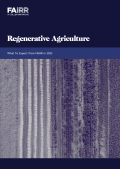Executive Summary
In September 2022, FAIRR launched a first-of-its-kind collaborative investor engagement focused on addressing the biodiversity risk driven by nutrient pollution from animal waste. The aim of the engagement is to drive pork and poultry producers to conduct meaningful risk assessments around their management of manure and animal waste and to put in place action plans that reduce their impact on biodiversity.
The importance of addressing biodiversity risks from inefficient use and management of nutrients is highlighted in the Kunming-Montreal Global Biodiversity Framework’s Target 7, which calls for reducing excess nitrogen and phosphorus loss to the environment by half by 2030.
The intensification of meat and dairy production combined with poor management of manure and animal waste will continue to drive nutrient loss to the environment, a planetary boundary already vastly exceeded. Hence livestock companies must address the biodiversity risk from nutrient pollution and transition towards more circular practices to effectively manage nutrients and minimise risks.
Report Highlights
The findings of this report offer FAIRR investor members:
Discussion of the four pillars of FAIRR’s assessment and key takeaways from dialogues.
Detailed company analysis and fully granular peer-group data comparison.
Near and longer-term engagement focus for each company.
Best practice examples and case studies.
Suggestions for follow-up questions to common company statements.
A practical guide for investors on the technicalities of using manure as fertiliser while limiting nutrient pollution risks.
Discussion of the potential opportunity of nutrient circularity and case studies of agrochemical companies.
Discussion of the misaligned global policy landscape.
Downloads
Key Findings
Brief overview of the engagement
A summary of the key takeaways from each engagement pillar
Detailed company analysis and peer-group data comparison
Near and longer-term engagement focus for each company
Best practice examples and case studies
Suggestions for follow-up questions to common company statements
Practical guide for investors on using manure as a fertiliser
Discussion of potential opportunities for nutrient circularity
Discussion of the global policy landscape on animal manure and wastes
Phase 1 Key FindingsProgress Report
Discussion of the four assessment pillars and key takeaways from dialogues
Detailed company analysis and peer-group data comparison
Near and longer-term engagement focus for each company
Best practice examples and case studies
Suggestions for follow-up questions to common company statements
Practical guide for investors on using manure as a fertiliser
Discussion of potential opportunities for nutrient circularity
Discussion of the global policy landscape on animal manure and wastes








